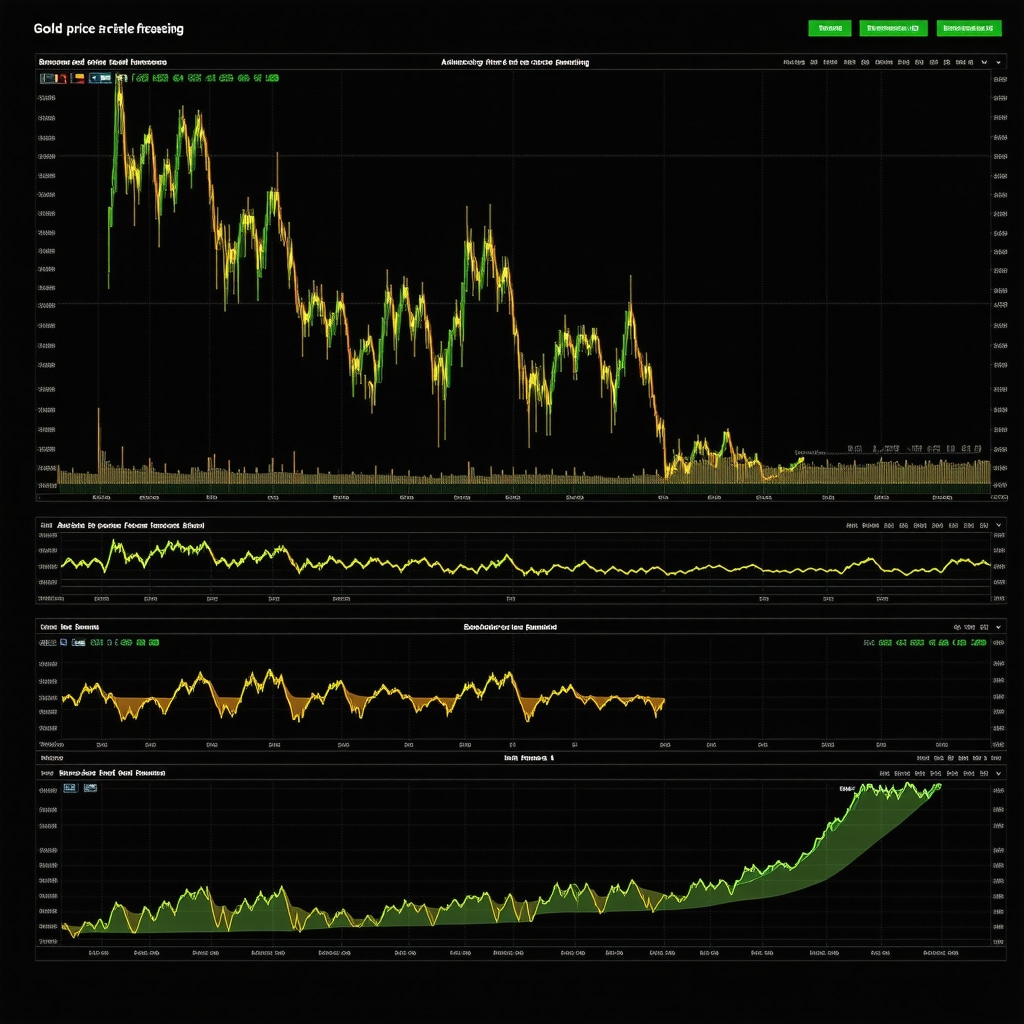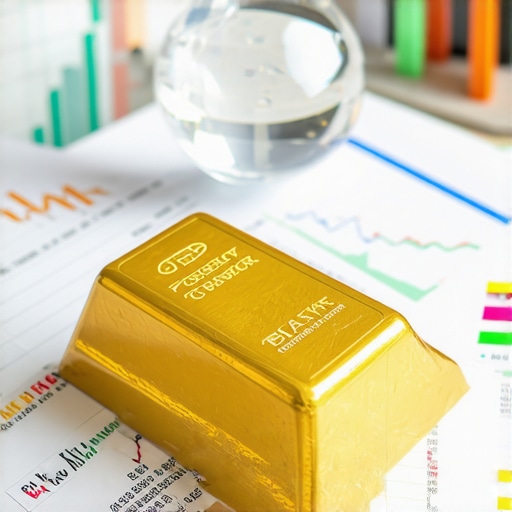Decoding the Art of Gold Price Forecasts: Beyond the Numbers
Investing in gold is often seen as a safe haven during economic uncertainty, but making smart decisions requires more than just trusting headline price predictions. The key to mastering gold investment lies in critically analyzing gold price forecasts through a multifaceted lens. By understanding the underlying factors driving these forecasts, investors can position themselves for better returns and avoid common pitfalls. This article dives deep into the nuances of gold price forecasting, providing you with expert perspectives that empower smarter investment choices.
Unveiling the Hidden Drivers: What Really Moves Gold Prices?
Gold price forecasts hinge on a complex interplay of economic, geopolitical, and market dynamics. Central bank policies, especially gold purchases and sales, wield significant influence by altering global supply and demand balances. For instance, as detailed in how central bank gold purchases affect global gold prices, shifts in reserves can trigger substantial price reactions. Additionally, inflation trends, currency fluctuations (especially the US dollar), and geopolitical tensions often serve as catalysts for price movements. Understanding these drivers equips investors to interpret forecasts with a critical eye rather than blind acceptance.
Forecasting Methods: From Technical Charts to Macro-Economic Models
Gold price predictions emerge from diverse methodologies. Technical analysts utilize historical price patterns, moving averages, and momentum indicators to anticipate short-term trends. Conversely, fundamental analysts examine macroeconomic data, including interest rates, inflation expectations, and supply-demand dynamics. Moreover, quantitative models integrating multiple variables have gained traction for their holistic approach. However, it’s vital to recognize the inherent uncertainties and assumptions baked into each model. A forecast based solely on one technique can be misleading; a synthesis of methods often yields a more balanced outlook.
How Can Investors Distinguish Reliable Gold Price Forecasts From Speculation?
Identifying trustworthy forecasts requires scrutiny of the source’s expertise, transparency of methodology, and historical accuracy. Established financial institutions and commodity research firms often provide robust analyses backed by comprehensive data. For example, authoritative reports from the World Gold Council or respected market analysts typically offer nuanced insights rather than sensationalized predictions. Investors should also be wary of overly optimistic or pessimistic forecasts lacking clear rationale. Cross-referencing multiple credible sources and understanding their assumptions can help filter out noise from actionable intelligence.
Integrating Gold Demand Trends and Market Sentiment for Sharper Insights
Beyond raw forecasts, interpreting gold demand trends in emerging markets and shifts in investor sentiment enhances forecast reliability. Rapid economic growth in regions like Asia can spur jewelry and industrial gold demand, pressuring prices upward. Additionally, tracking sentiment indicators—such as ETF inflows or gold futures positioning—reveals market psychology that often precedes price moves. Resources like using gold demand trends to predict price movements provide valuable context for these dynamics. This layered approach enables investors to anticipate price trajectories more effectively than relying solely on numerical forecasts.
Practical Wisdom: Applying Forecast Analysis to Your Investment Strategy
Experience shows that blending forecast analysis with risk management yields the best outcomes in gold investing. For example, seasoned investors often scale their positions over time, reacting to forecast revisions and market shifts rather than making lump-sum bets. Diversifying gold holdings across physical bullion, ETFs, and mining stocks—each influenced differently by price changes—can stabilize returns. Moreover, staying informed about regulatory changes, geopolitical developments, and monetary policy updates allows timely adjustments. Combining analytical rigor with flexible strategy transforms forecasts from mere predictions into actionable guides.
For more detailed strategies on balancing risk and reward in gold investments, explore our guide on gold investment strategies for a volatile market.
Engage with us: Have you applied gold price forecasts in your investment decisions? Share your experiences or questions in the comments below to join a community of informed investors.
For authoritative insights on gold’s role as a hedge against economic uncertainty, the International Monetary Fund’s analysis offers a comprehensive perspective.
Reflecting on Real-World Gold Investment Experiences
Over the years, I’ve noticed that the true challenge in gold investing isn’t just understanding the forecasts but adapting them to your unique financial goals and risk tolerance. For instance, when gold prices surged unexpectedly during a geopolitical crisis, I realized that relying solely on static predictions can leave you unprepared. Instead, staying flexible and attuned to market sentiment proved invaluable. This hands-on approach helped me avoid knee-jerk reactions and instead make measured decisions aligned with my long-term strategy.
Why Emotional Intelligence Matters More Than You Think
One lesson that often gets overlooked is the role of emotional intelligence in interpreting forecasts. Gold markets can be volatile, and the pressure to act quickly can lead to impulsive decisions. I’ve found that pausing to assess your emotional state before making moves helps maintain clarity. Understanding your own biases and fears can make the difference between a rash sell-off and a well-timed investment. This personal insight complements technical analysis, creating a more holistic investment mindset.
Could Your Gold Investment Strategy Benefit from Understanding Behavioral Finance?
Behavioral finance explores how psychology affects financial decision-making. For gold investors, this means recognizing patterns like herd mentality or overconfidence that can skew perception of forecasts. Have you ever bought gold simply because everyone else was doing it, or ignored a promising forecast due to skepticism? These are common yet powerful influences. Learning to identify and manage them can elevate your investment outcomes significantly.
Incorporating Trusted External Insights to Sharpen Your Forecast Analysis
In my journey to refine gold investment strategies, I turned to resources like the International Monetary Fund’s analysis on gold as a hedge against economic uncertainty. Their comprehensive reports provide a macroeconomic backdrop that deepens my understanding of price drivers beyond market noise. Combining such authoritative perspectives with personal experience has been instrumental in crafting a balanced approach. For those interested, exploring this IMF analysis is highly recommended.
Practical Steps to Apply Forecasts with Confidence
From my experience, one effective tactic is to use forecasts as a guide rather than gospel. For example, I monitor forecast revisions and market sentiment indicators like ETF inflows, which can signal emerging trends. Coupling this with a well-diversified portfolio — spanning physical bullion, ETFs, and mining stocks — cushions against unexpected swings. This strategy is detailed further in our gold investment strategies for a volatile market guide, which I often revisit to stay updated.
Join the conversation: What’s your experience with gold price forecasts? Have you found any strategies or insights that helped you navigate market shifts? Share your stories or questions below — your perspective might just be the insight another investor needs.
Behavioral Finance and Gold: Navigating the Psychological Currents Behind Forecast Reactions
Integrating behavioral finance into gold price forecasting unlocks a deeper layer of market understanding that transcends pure data analysis. Investors are not always rational actors; cognitive biases such as anchoring, loss aversion, and confirmation bias frequently distort judgment in volatile gold markets. Recognizing these psychological patterns enables investors to anticipate herd behavior and market overreactions that traditional models might miss.
For example, during periods of sharp geopolitical tension, fear-driven buying can push gold prices beyond fundamental values. Conversely, post-crisis complacency often leads to premature sell-offs. By monitoring sentiment indices alongside technical indicators, sophisticated investors can better time entries and exits, effectively riding the waves of collective emotion rather than being swept away by them.
What are the Most Effective Behavioral Indicators to Integrate in Gold Forecasting Models?
Key behavioral indicators include measures of investor sentiment derived from ETF flow data, options market skewness, and social media analytics. ETF inflows and outflows reflect aggregated investor confidence or fear, often preceding price shifts. Options skewness reveals asymmetry in market expectations, signaling potential directional bias or hedging activity. Additionally, emerging tools analyzing social media chatter and news sentiment provide real-time gauges of market psychology.
Academic research, such as that published in the Journal of Behavioral and Experimental Finance, emphasizes combining these behavioral metrics with traditional financial models to improve predictive accuracy. This hybrid approach represents the cutting edge of gold price forecasting, capturing complexities that purely quantitative or fundamental analyses might overlook.
Quantitative Innovations: Machine Learning and AI in Gold Price Prediction
Recent advances in machine learning (ML) and artificial intelligence (AI) have revolutionized forecasting by enabling models to process massive, multifaceted datasets encompassing macroeconomic indicators, market sentiment, and even geopolitical event probabilities. Unlike conventional econometric models, ML algorithms can uncover non-linear relationships and subtle interactions among variables that influence gold prices.
Techniques such as gradient boosting, recurrent neural networks (RNNs), and reinforcement learning have shown promise in capturing both short-term volatility and long-term trends. However, these models require careful calibration and validation to avoid overfitting and ensure robustness under changing market regimes.
One notable example is the application of RNNs to time series data integrating gold ETF flows, dollar index fluctuations, and inflation expectations, which has yielded improved forecasting performance in out-of-sample tests, as documented in recent quantitative finance studies.
Balancing Complexity and Interpretability in Forecasting Models
While AI-driven models offer enhanced predictive power, their “black box” nature can pose challenges for investor trust and practical decision-making. Therefore, combining advanced algorithms with explainable AI (XAI) techniques is essential. XAI methods, such as SHAP (SHapley Additive exPlanations) values, provide transparency by quantifying the contribution of each input variable to the model’s predictions.
This transparency allows investors to understand why a particular forecast suggests a bullish or bearish outlook, facilitating more confident and informed investment decisions. Moreover, blending machine learning outputs with expert judgment creates a symbiotic relationship where human insight guides algorithmic interpretation, resulting in a more nuanced and adaptive forecasting framework.
Ready to elevate your gold investment strategy? Explore our in-depth resources on integrating behavioral finance and AI-driven forecasting techniques to stay ahead in the dynamic gold market.
Behavioral Finance Nuances: Decoding Investor Psychology in Gold Markets
Incorporating behavioral finance into gold price forecasts transcends conventional analytics by accounting for cognitive biases and market sentiment oscillations that often distort price signals. Investors’ tendencies toward herd behavior, loss aversion, and confirmation bias can exacerbate volatility beyond what fundamental data would suggest. By systematically tracking sentiment metrics—like ETF flows and options market skewness—investors gain a predictive edge, anticipating market overreactions and timing entries with greater precision.
What Are the Most Effective Behavioral Indicators to Integrate in Gold Forecasting Models?
Key behavioral indicators encompass ETF inflows and outflows, which reflect aggregate investor confidence or fear, options market skewness signaling directional biases, and emerging real-time social media sentiment analytics. These metrics provide a dynamic barometer of collective psychology, often preceding price movements. Academic research in the Journal of Behavioral and Experimental Finance underscores the efficacy of combining these behavioral signals with traditional models to enhance forecasting accuracy.
Harnessing Machine Learning: The Frontier of Gold Price Prediction
Machine learning (ML) and artificial intelligence (AI) techniques have ushered in a paradigm shift, enabling the assimilation of vast, heterogeneous datasets including macroeconomic indicators, geopolitical risk probabilities, and sentiment indices. Advanced algorithms like gradient boosting machines, recurrent neural networks (RNNs), and reinforcement learning frameworks adeptly capture complex, non-linear relationships and temporal dependencies in gold prices. However, meticulous model tuning and validation are imperative to mitigate overfitting and adapt to regime shifts.
Notably, RNN applications integrating gold ETF flows, US dollar index fluctuations, and inflation expectations have demonstrated superior out-of-sample forecasting performance, suggesting AI’s growing indispensability in contemporary gold market analysis.
Balancing Predictive Power with Transparency: The Role of Explainable AI
Despite their sophistication, AI models often suffer from opacity, limiting investor trust and practical utility. Explainable AI (XAI) methodologies, such as SHAP (SHapley Additive exPlanations), illuminate model decisions by attributing the influence of each input variable on predicted outcomes. This transparency fosters investor confidence and facilitates nuanced interpretation of forecasts.
Blending algorithmic outputs with expert judgment creates a synergistic framework, where human insights guide model interpretation, enhancing adaptability to evolving market conditions and reducing reliance on black-box predictions.
Ready to elevate your gold investment strategy? Dive into our comprehensive resources on integrating behavioral finance insights and AI-driven forecasting techniques to maintain a competitive edge in the ever-evolving gold market.

Frequently Asked Questions (FAQ)
What factors most significantly influence gold price forecasts?
Gold prices are primarily influenced by a combination of macroeconomic variables such as inflation rates, interest rate policies, and currency fluctuations (especially the US dollar), geopolitical events, and central bank gold reserve activities. These drivers interact dynamically, making forecasting complex and requiring a multifaceted approach.
How reliable are technical analysis methods compared to fundamental analysis in predicting gold prices?
Technical analysis focuses on historical price patterns and market momentum, offering insights into short-term trends. Fundamental analysis evaluates economic indicators and supply-demand dynamics for longer-term perspectives. Both have strengths and limitations; combining them alongside quantitative and behavioral models typically yields more robust forecasts.
Why should investors consider behavioral finance when interpreting gold price forecasts?
Behavioral finance highlights how cognitive biases and market sentiment can distort price movements beyond fundamental values. Recognizing investor behaviors such as herd mentality or loss aversion helps anticipate overreactions and timing opportunities, enhancing decision-making beyond what traditional models suggest.
What role do machine learning and AI play in modern gold price forecasting?
Machine learning and AI enable processing of large, complex datasets to uncover non-linear relationships and hidden patterns influencing gold prices. Techniques like recurrent neural networks and gradient boosting improve predictive accuracy but require careful tuning to avoid overfitting. Explainable AI methods further help interpret these complex models.
How can investors balance the complexity of AI-driven forecasts with the need for transparency?
Integrating explainable AI (XAI) tools, such as SHAP values, allows investors to understand the contribution of each factor in AI predictions. Blending these insights with expert human judgment creates a transparent and adaptive forecasting framework that supports informed investment decisions.
Are gold price forecasts sufficient alone to make investment decisions?
No. Forecasts should be one element of a comprehensive strategy that includes risk management, portfolio diversification, and ongoing monitoring of geopolitical and economic developments. Relying solely on forecasts without consideration of these factors can increase exposure to unforeseen risks.
How can investors identify credible gold price forecasts amid market noise?
Credible forecasts come from established institutions with transparent methodologies and demonstrated track records. Cross-referencing multiple reputable sources, examining underlying assumptions, and avoiding sensationalized predictions help distinguish reliable analyses from speculation.
What behavioral indicators are most effective in forecasting gold price movements?
Key indicators include ETF inflows/outflows, options market skewness, and real-time sentiment analytics from social media and news. These metrics reflect aggregated investor psychology and often precede price changes, providing valuable signals beyond traditional financial data.
How do geopolitical events shape gold price forecasts?
Geopolitical tensions often trigger risk aversion, increasing demand for gold as a safe haven and driving prices upward. Forecast models that incorporate geopolitical risk probabilities can better anticipate sudden price shifts linked to such events.
What practical steps can investors take to apply gold price forecasts effectively?
Investors should use forecasts as guides rather than certainties, monitor revisions and sentiment indicators, diversify holdings across bullion, ETFs, and mining stocks, and stay informed on economic and regulatory developments. Combining analytical rigor with flexibility enhances investment outcomes.
Trusted External Sources
- World Gold Council (WGC): Provides authoritative data on gold demand, supply, and market trends, essential for understanding fundamental drivers behind price movements.
- International Monetary Fund (IMF): Offers comprehensive analyses on gold’s role in global economic stability and as a hedge against uncertainty, enriching macroeconomic perspectives.
- Journal of Behavioral and Experimental Finance: Publishes peer-reviewed research on behavioral finance applications in commodity markets, informing integration of psychological factors into forecasting models.
- National Bureau of Economic Research (NBER): Delivers rigorous economic studies and working papers that examine the interplay of macroeconomic variables affecting precious metals.
- Quantitative Finance Journals and Conferences: Sources of cutting-edge research on machine learning and AI methodologies applied to financial forecasting, highlighting advancements in predictive techniques.
Conclusion
Mastering gold price forecasts requires a holistic approach that transcends simple numerical predictions. By integrating fundamental analysis, behavioral finance insights, and advanced AI-driven models, investors gain a nuanced understanding of the multifaceted factors driving gold prices. Recognizing the psychological currents behind market moves and applying explainable, transparent forecasting methods enables more confident and adaptive investment decisions. Ultimately, blending these expert insights with disciplined risk management and diversification strategies transforms forecasts from uncertain guesses into valuable guides for navigating the dynamic gold market. Engage with this knowledge by sharing your experiences, asking questions, or exploring related expert resources to sharpen your gold investment acumen and stay ahead in an ever-evolving landscape.









